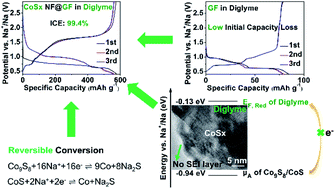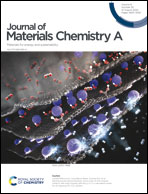Cobalt sulfide nanoflakes grown on graphite foam for Na-ion batteries with ultrahigh initial coulombic efficiency†
Abstract
Sodium-ion batteries (SIBs) are regarded as promising low-cost alternatives to the prevailing lithium-ion batteries. However, most anode materials for SIBs suffer from low initial coulombic efficiency (ICE), limiting their commercial applications. Herein, we demonstrate a Na-ion anode with an extremely high ICE of 99.4%, based on cobalt sulfide (Co9S8/CoS) nanoflakes grown on graphite foam (GF) in a diglyme-based electrolyte. The achievement of such a high ICE can be ascribed to the following three aspects: (i) negligible side reactions between a diglyme-based electrolyte and Co9S8/CoS, owing to a much higher Fermi level of diglyme reduction than anode potential μA of Co9S8/CoS, which can block electron transfer from the anode to the electrolyte, (ii) highly reversible conversion reaction of Co9S8/CoS, and (iii) much lower initial capacity loss of substrate GF, compared with other sorts of carbon. The underlying rules revealed in this study serve as general guidelines in the development of sodium-ion anodes to achieve superb ICE.



 Please wait while we load your content...
Please wait while we load your content...